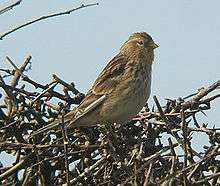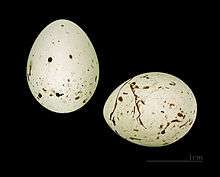Twite
| Twite | |
|---|---|
 | |
| Scientific classification | |
| Kingdom: | Animalia |
| Phylum: | Chordata |
| Class: | Aves |
| Order: | Passeriformes |
| Family: | Fringillidae |
| Genus: | Linaria Bechstein, 1802 |
| Species: | L. flavirostris |
| Binomial name | |
| Linaria flavirostris (Linnaeus, 1758) | |
| Subspecies | |
|
see text | |
| Synonyms | |
|
Carduelis flavirostris | |

The twite (Linaria flavirostris) is a small brown passerine bird in the finch family Fringillidae.
It is similar in size and shape to a linnet, at 13 to 13.5 centimetres (5.1 to 5.3 in) long. It lacks the red head patch and breast shown by the linnet and the redpolls. It is brown streaked with black above, and a pink rump. The underparts are buff to whitish, streaked with brown. The conical bill is yellow in winter and grey in summer. The call is a distinctive twit, from which its name derives,[2] and the song contains fast trills and twitters.[3] Twites can form large flocks outside the breeding season, sometimes mixed with other finches on coasts and salt marshes. They feed mainly on seeds.
The twite breeds in northern Europe and across central Asia. Treeless moorland is favoured for breeding. It builds its nest in a bush, laying 5–6 light blue eggs.[4] It is partially resident, but many birds migrate further south, or move to the coasts.[5] It has declined sharply in parts of its range, notably Ireland.[6]
In the UK, the Twite is subject to several research projects in the Pennines, the Scottish Highlands and the North wales and Lancashire coast lines. Records show that the birds to the east of the Pennine hills move to the southeast coast in winter and those to the west winter between Lancashire and the Hebrides. The Welsh population winters almost exclusively in Flintshire.
In 1758 Carl Linnaeus included the species in the 10th edition of his Systema Naturae under the binomial name Fringilla flavirostris.[7][8]
The genus name linaria is the Latin for a linen-weaver, from linum, "flax" and 'flavirostris means yellow-billed.[9]
The twite and the closely related linnets were at one time placed in the genus Carduelis but were moved to a separate genus Linaria based on a phylogenetic analysis of mitochondrial and nuclear DNA sequences.[10][11]
There are 10 recognised subspecies:[10]
- L. f. bensonorum (Meinertzhagen, R, 1934) - Outer Hebrides (western Scotland) (sometimes included in pipilans)[12]
- L. f. pipilans (Latham, 1787) - northern Ireland and northern Britain
- L. f. flavirostris (Linnaeus, 1758) - northern Scandinavia and northwestern Russia
- L. f. brevirostris (Bonaparte, 1855) - Turkey, the Caucasus and northern Iran
- L. f. kirghizorum (Sushkin, 1925) - northern and central Kazakhstan
- L. f. korejevi (Zarudny & Harms, 1914) - northeastern Kazakhstan to northwestern China
- L. f. altaica (Sushkin, 1925) - southwestern Siberia, northern and western Mongolia
- L. f. montanella (Hume, 1873) - Kyrgyzstan to western China
- L. f. pamirensis (Zarudny & Harms, 1914) - Tajikistan, northern Afghanistan and northwestern Pakistan (sometimes included in montanella)[12]
- L. f. miniakensis (Jacobi, A, 1923) - eastern Tibet and western China
- L. f. rufostrigata (Walton, 1905) - western and southern Tibet, northern India and northern Nepal
References
- ↑ BirdLife International (2012). "Carduelis flavirostris". IUCN Red List of Threatened Species. Version 2013.2. International Union for Conservation of Nature. Retrieved 26 November 2013.
- ↑ "Twite". Oxford English Dictionary (3rd ed.). Oxford University Press. September 2005. (Subscription or UK public library membership required.)
- ↑ Clement, Harris & Davis 1993, pp. 246–247
- ↑ Perrins 1987, p. 196
- ↑ Newton 1973
- ↑ BirdWatch.Ireland. "Irish Twite danger". BirdLife Europe. BirdLife International. Retrieved 12 August 2014.
- ↑ Paynter, Raymond A. Jnr., ed. (1968). Check-list of birds of the world, Volume 14. Cambridge, Massachusetts: Museum of Comparative Zoology. p. 253.
- ↑ Linnaeus, C. (1766). Systema Naturæ per regna tria naturae, secundum classes, ordines, genera, species, cum characteribus, differentiis, synonymis, locis, Volume 1 (in Latin) (10th ed.). Holmiae:Laurentii Salvii. p. 182.
- ↑ Jobling, James A. (2010). The Helm Dictionary of Scientific Bird Names. London, United Kingdom: Christopher Helm. pp. 161, 227. ISBN 978-1-4081-2501-4.
- 1 2 Gill, Frank; Donsker, David (eds.). "Finches, euphonias". World Bird List Version 5.2. International Ornithologists' Union. Retrieved 5 June 2015.
- ↑ Zuccon, Dario; Prŷs-Jones, Robert; Rasmussen, Pamela C.; Ericson, Per G.P. (2012). "The phylogenetic relationships and generic limits of finches (Fringillidae)" (PDF). Molecular Phylogenetics and Evolution. 62 (2): 581–596. doi:10.1016/j.ympev.2011.10.002.
- 1 2 Clement, P. "Twite (Carduelis flavirostris)". In del Hoyo, J; Elliott, A.; Sargatal, J.; Christie, D.A.; de Juana, E. Handbook of the Birds of the World Alive. Lynx Edicions. Retrieved 6 June 2015.(subscription required)
Works cited
- Clement, Peter; Harris, Alan; Davis, John (1993). Finches and Sparrows: an Identification Guide. Princeton, New Jersey: Princeton University Press. ISBN 0-691-03424-9.
- Newton, Ian (1973). Finches. The New Naturalist Library 55. New York: Taplinger. ISBN 0-8008-2720-1.
- Perrins, Christopher M. (1987). New Generation Guide to the Birds of Britain and Europe. Austin, Texas: University of Texas Press. ISBN 0-292-75532-5.
External links
| Wikimedia Commons has media related to Carduelis flavirostris. |
